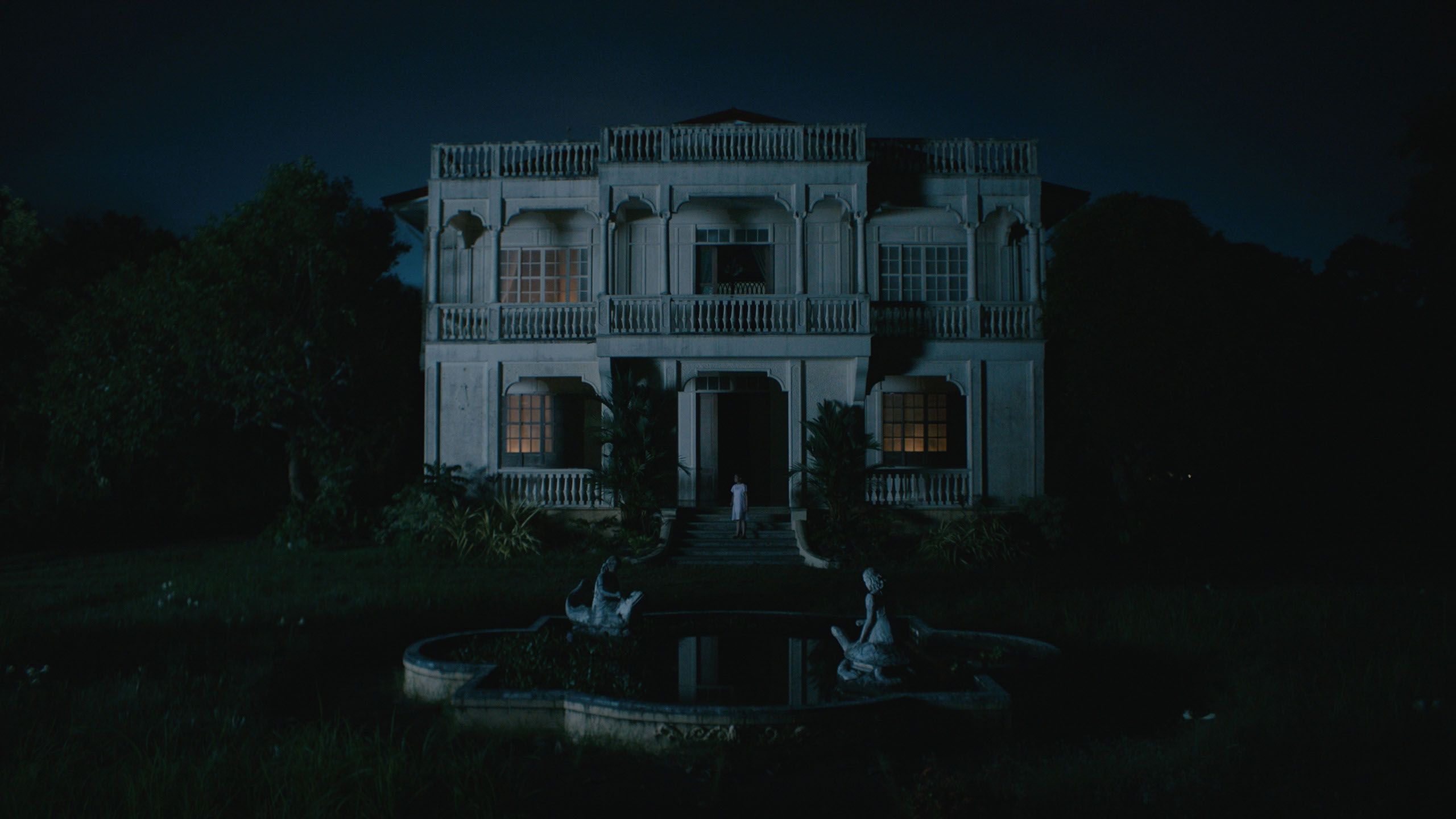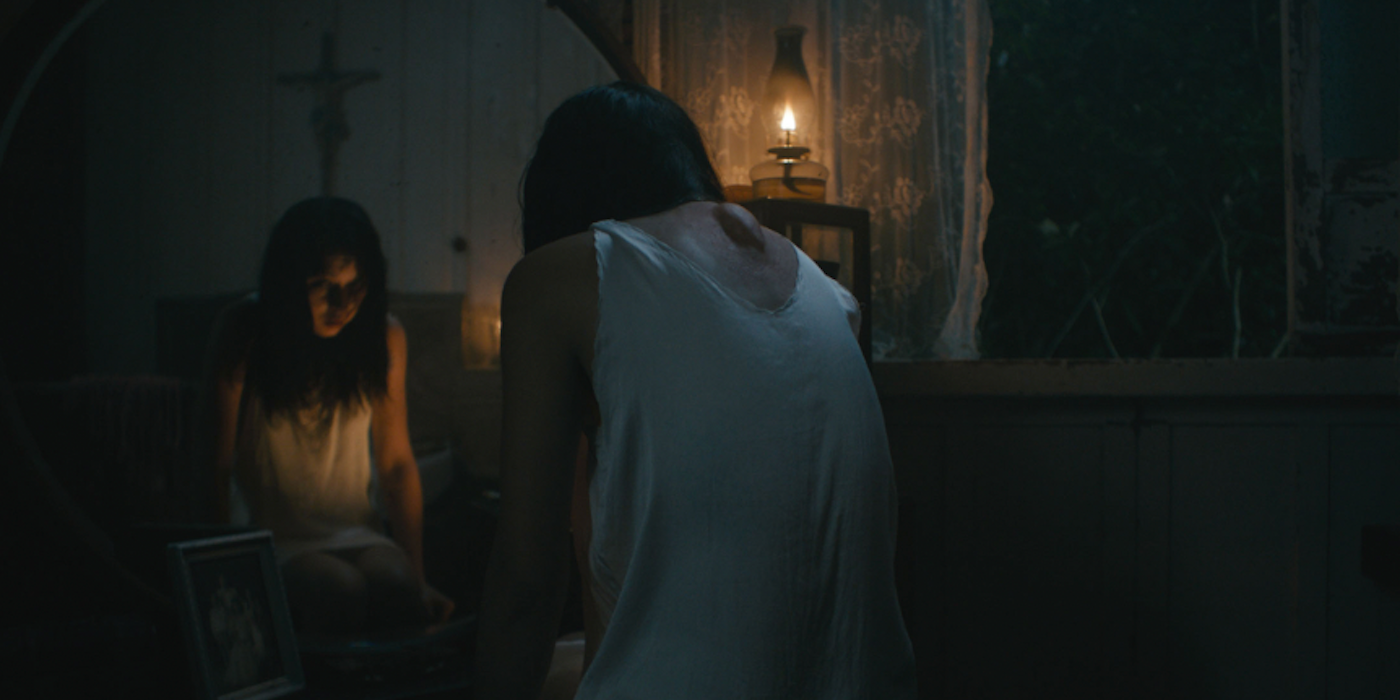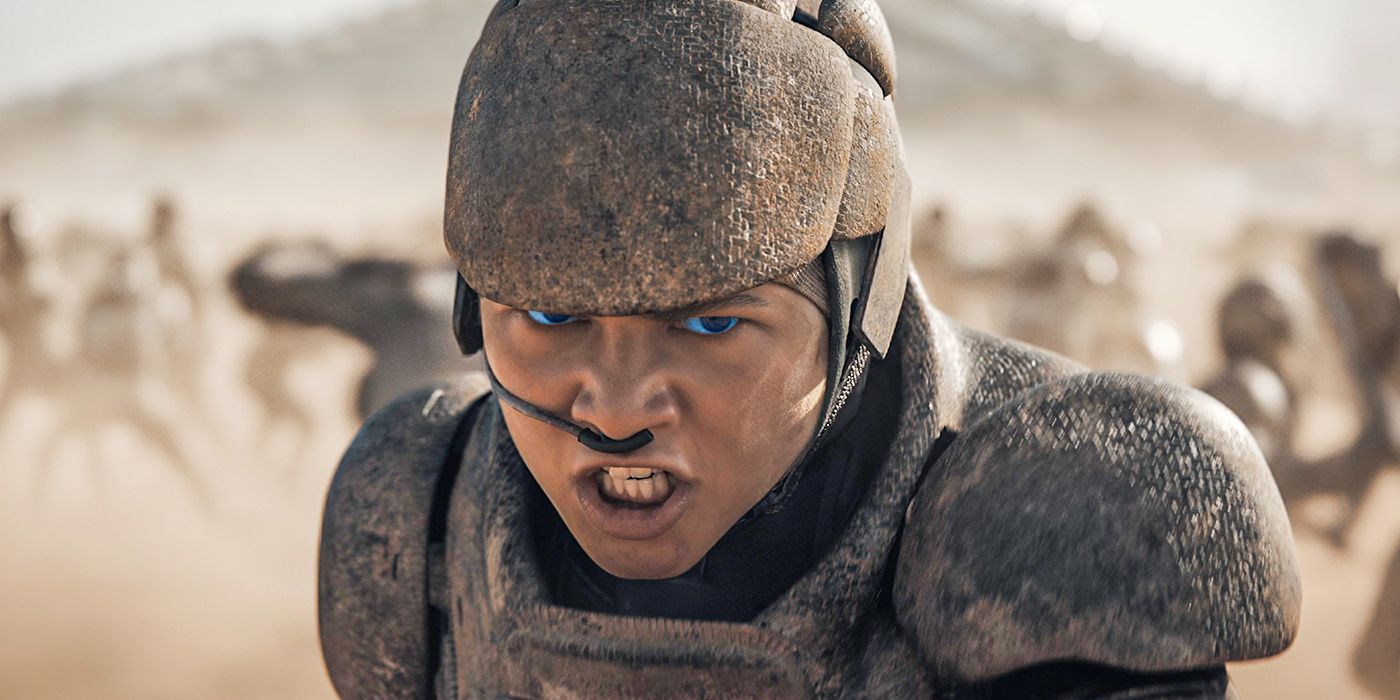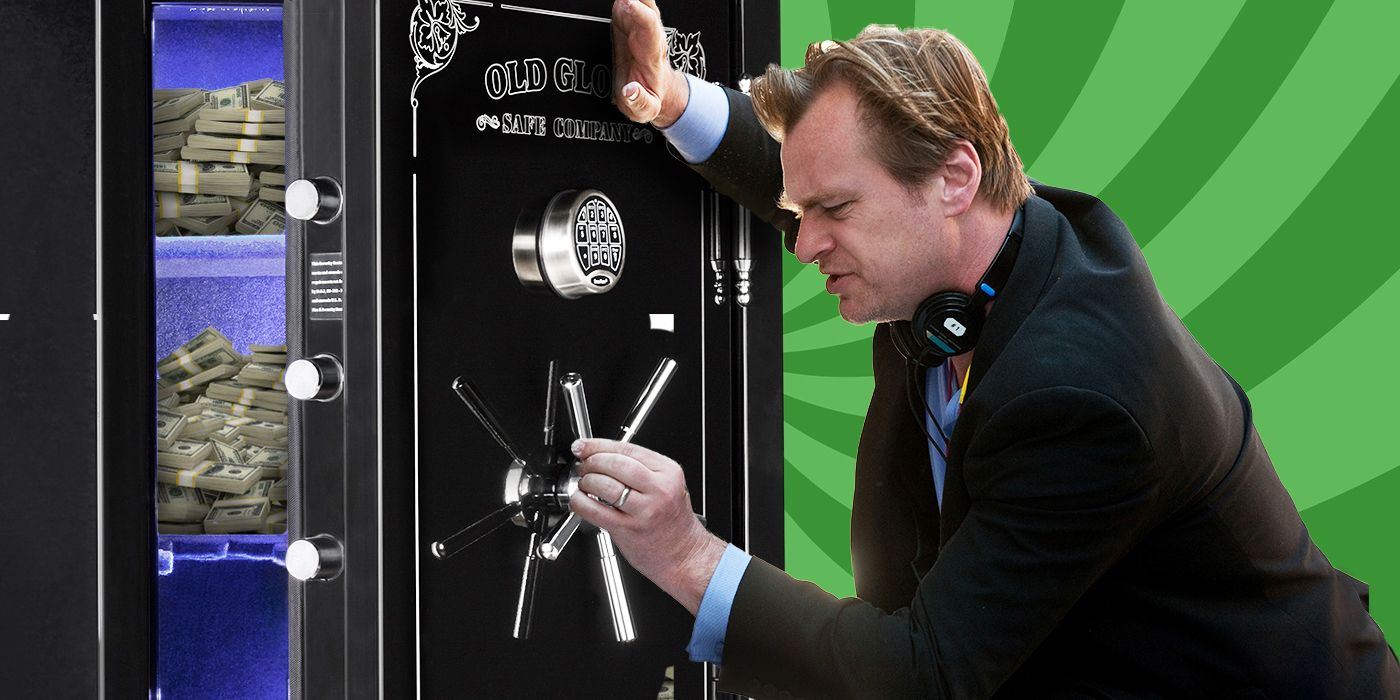Prime Video wasn’t about to let anyone else snatch up In My Mother’s Skin at the 2023 Sundance Film Festival. Before the movie’s January 20th debut, the streamer claimed the global distribution rights to the much-praised Midnight line-up selection.
Writer-director Kenneth Dagatan’s second feature takes place in the Philippines at the tail end of World War II. Tala (Felicity Kyle Napuli) and her little brother Bayani (James Mavie Estrella) must stay home with their ailing mother (Beauty Gonzalez) while their father (Arnold Reyes) attempts to free the family from the Japanese. When their mother’s condition worsens, a desperate Tala accepts the gifts of a fairy played by Jasmine Curtis-Smith who promises to cure her. Unfortunately, this fairy’s intentions aren’t as pure as Tala hopes.
While in Park City for In My Mother’s Skin’s big premiere, Dagatan and Curtis-Smith swung by the Crumpa Studio presented by Saratoga Spring Water to discuss the evolution of the story, its use of Filipino mythology, how Willem Dafoe’s performance in The Lighthouse influenced Curtis-Smith’s approach to bringing The Fairy to screen, and loads more.
You can catch it all in the video at the top of this article or in the transcript below.
Your movie burrowed its way into my brain and it’s not leaving, cicada style.
JASMINE CURTIS-SMITH: Cicadas are awesome creatures. They really just feed and feed, and I’m glad to be the queen of cicadas.
KENNETH DAGATAN: And the process of the rebirth, that was the purpose of having cicadas for your character.
CURTIS-SMITH: Correct! Because initially, it was a different insect, right?
DAGATAN: A beetle, but my production designer, Ben Padero, and his partner, Carlo Tabije, told me maybe we can play around with the cicada element because of the rebirth.
Perfect pairing there! Kenneth, I’m gonna give this duty to you because our audience might not know what your movie is just yet. Can you give a brief synopsis of In My Mother’s Skin?
DAGATAN: The film happens in the last months of World War II and you follow this young innocent protagonists named Tala, and together with her younger brother and her very sick mother, they wait for their father to arrive in this isolated mansion. And then one day, when the mother gets very sick, Tala is forced to accept help coming from a flesh-eating fairy played by Jasmine Curtis-Smith that promised her protection.
I’ll get to this more later, but because you just name-dropped Tala, she’s so good. How does a young actor carry a movie like this?
DAGATAN: She’s so amazing. I’m still in awe working with her. I mean, working with you guys.
CURTIS-SMITH: Oh my gosh, no, even as a co-actor whenever I shared the set and the scene with her, she commands attention, and as the fairy I’m meant to be the one commanding the scene. And I feel like the way she reacts, she absorbs everything. And she’s 15, is that right?
DAGATAN: Fifteen. She just turned 16.
CURTIS-SMITH: She just turned 16, but she does have a lot of theater background. She’s amazing.
Whatever experiences she had, whoever trained her, A+ work because she is something else in this.
I wanted to go back to the beginning because it is a feat to get a first feature off the ground, and I feel like many think that after you do it once, you could do it again. Was that the case with this film? Was it difficult or was it easier now that you had another film under your belt?
DAGATAN: It’s a bit weird because I wrote this concept way, way back in 2015 as a short film, and it was based off a French film and Pan’s Labyrinth by Guillermo del Toro. I think it’s obvious. [Laughs]
I like any reference to Guillermo, and you could feel it and I like that feeling.
DAGATAN: So I made this as a short film and eventually I had the privilege to made my first feature film, which is called Ma. And then after that, 2018, I discovered the concept again and approached my producers from Epicmedia, Brad [Liew] and Bianca [Balbuena], to maybe play around with this story that I really want to tell. And then the process [was] a bit long for a Filipino project. It’s a bit long because we started writing [in] 2018, so it’s like four years of writing and developing and research. It’s a really amazing, fun process talking with everyone, giving ideas about the story, and we’re very happy to have this kind of story now.
Many, many years of work went into writing the script. What would you say is the biggest difference between how you initially pictured this movie panning out and the movie you wound up with in the end?
DAGATAN: Everything is compromise. [Laughs] But I’m very happy [with] how it came out. In the short film, when I first wrote this story, it was a period-less film. I don’t know the setting or the milieu of this film. And then cut to 2020 when the pandemic hits, I was talking with my father and he was telling me the story of my grandfather who was a guerrilla soldier way, way back in World War II. And he was telling me [about] the anxiety, the claustrophobia, the depression of war and having that external enemy come in your house. And it’s World War II and I felt the same way when the pandemic happened. So I told my producers, I think we need to make this a World War II [film]. I think that’s the biggest difference between the short and this one.
That’s a very, very effective element you added.
Jasmine, you get this script and I’ve got to imagine there are some big burning questions about what your character is capable of and what she’s all about. When you first get the script, what were some of the biggest questions you had for Kenneth in order to fully be able to access what’s going through her mind?
CURTIS-SMITH: Initially, I really just wanted to understand, first, how she would visually appear. What did she look like? Because that in itself is a big factor when you’re watching horror films, right? What this flesh-eating fairy — she’s not a fairy, you know? She’s flesh-eating! She invades the body of the person that she attacks, and so I felt like having that firsthand picture or visual imagination helped me go back to the script and reread it again.
And just the fact that there was this play on her looking like a religious artifact or saint or statue or Mother Mary. Actually, the costume in itself looks like our baby Jesus, Santo Niño in the Philippines because he has the frame around his face, he has all the embellishments on the big garments that they wear, and it looks exactly like what the fairy looks like. And so I felt that that was such a freaky way of incorporating religion, hope and, at the same time, horror. That mix of religion and horror I think is a big thing, especially in our country because we’re mainly Roman Catholic. So that was what got me to jump on and start asking questions like, how serious do you want the character to be? Do you want her to be freaky and scary right away? Kenneth told me that he really wanted her to have this kind of solemn feel, that every time she would come on screen, it wasn’t like a jump scare. You didn’t have that traditional fear. It was kind of like a simmering fear every time she would pop up.
Great success in that respect! I don’t know if I’m getting too specific about it, but how much are you thinking about every little nuance in your facial expressions? Any little twitch, different look, or even if your eyebrows move a certain way, that can completely change the tone of a moment.
CURTIS-SMITH: Oh, yeah, definitely. And I would often ask him if he would be bothered by certain movements that I would make with my face because sometimes I would be conscious about my forehead and I really wanted her to come off as this statuesque porcelain facade so that that would initiate the freakishness of The Fairy character. But he said no, it’s okay, that’s fine because it also adds character and depth to The Fairy without you having to show too much emotion. We also played around with the voice. We experimented [with] how we wanted that. And then in post, we did a few recordings of how to add just another layer, but still using the original voice that we used on set.
DAGATAN: But you were the one who gave me the idea of a fairy not blinking at all.
CURTIS-SMITH: That’s right. That’s right.
How do you do that?
CURTIS-SMITH: The biggest inspiration was the scene in The Lighthouse with Willem Defoe. He was saying I think a three minute line and his eyes were peeled open and that freaked me out. When I was watching that scene for the first time, I wasn’t sure if I wasn’t blinking. Was I blinking the same time he was blinking? So I had to rewatch the scene again and that freaked me out watching it, and his presence and energy in that scene. So I think I wanted that. I wanted to bring that to The Fairy.
DAGATAN: And it really worked.
I’m always eager to know about lore and movie bibles, so how much did you think all of that through with The Fairy in terms of where she came from, why she’s there in particular, if she has an end goal or if it’s just this constant cycle that can never be broken?
DAGATAN: The lore of the film is basically based on the existing mythology in the Philippines, which is the Aswang which is the monster and the Engkanto which is The Fairy. And growing up as a kid in the province, even in the Philippines, you keep hearing the stories about the Aswang and Engkantos, and Engkantos living inside this tree and giving powers or even giving fruits to the people. And growing up listening to that, it really struck me. For sure for you, right?
CURTIS-SMITH: Oh yeah, because these are things you would hear from your aunties, uncles, your parents. And they tried to scare you with it, like don’t go out late at night.
DAGATAN: In this film, I really wanted to give something new towards that lore, towards that mythology. That’s why I reinvented some things just to make it something new, and I’m really happy that it came out this way.
One thing that randomly crossed my mind, I don’t know if you’ve considered it, but how do you think the story might have changed if it was Bayani and not Tala who encountered The Fairy?
DAGATAN: That’s a good question! In my head, it’s a young girl living in this adult life, living with a lot of grown ups and [having] lost her innocence in a way. I want Talas’ character to show the fairy tale side of this very crazy, scary world, which is the World War, and for Bayani, I really want him to to see the real horror of the war. That’s why I really want them to contrast and build each other, and I’m happy with these kid actors that they really pull this off.
Bringing up the kids here, Jasmine, even with all of your experience, is there anything you saw the two of them do on this set that you wish you could go back in time and tell yourself to try when you were first starting?
CURTIS-SMITH: Oh yeah, definitely. These kids are just fantastic and they take direction so well. They’re very patient. In these times where patience is kind of running out because [of] how fast our social media clocks [are] running, but they’re able to really live in the moment and take direction from our acting coaches as well on set, and even just from co-actors. So I think that’s what I would tell myself if I was going back 14 years ago, I’d be like, ‘Hey, girl, just listen, trust. Yes, you know things, but trust because there’s a bigger picture here.’
DAGATAN: And to add on that, I wrote Bayani’s character really differently from what you saw in the film. I wrote Bayani’s character as this crybaby, timid, scaredy cat kind of boy. But when I saw James Mavie Estrella for the first time, he gave a different persona to the character and I really wanted that persona. So I changed everything for that persona, and it really worked. I am very happy I revised in the script. [Laughs]
Oh, it works!
I always hesitate to ask ‘what’s next’ at a festival when you’re celebrating the miracle of making a movie, but I’ve seen a lot pieces out there that say, if you want a horror director to keep an eye on, look at you. I love all storytelling, but horror is my number one and now I would like to keep you in this genre, so is there any particular theme or corner of horror that you’ve yet to tap into that you’d be eager to explore in a future film?
DAGATAN: I’m developing a project right now and it’s all about [the] generational gap. I really want to touch on that topic. And it’s all about old people and I want to make it magic realism in a way and there’s a touch of horror in it. But it’s all about this generational gap between new generations and old ones, and I really want to tap [into] that.
Special thanks to our 2023 partners at Sundance including presenting partner Saratoga Spring Water and supporting partners Marbl Toronto, EMFACE, Sommsation, Hendrick’s Gin, Stella Artois, mou, and the all-electric vehicle, Fisker Ocean.








